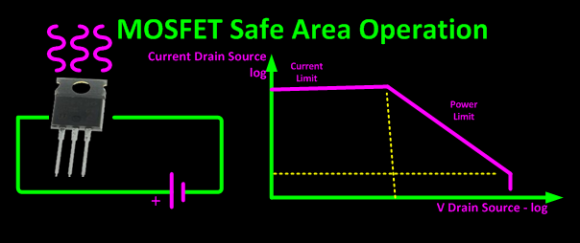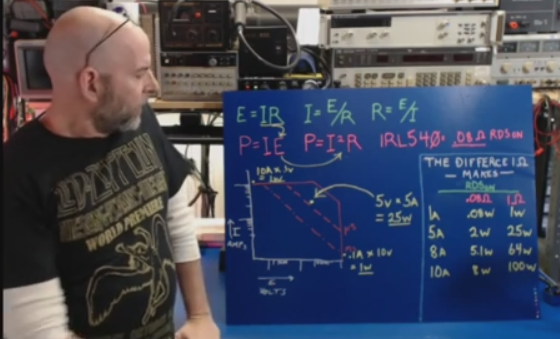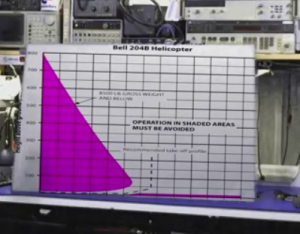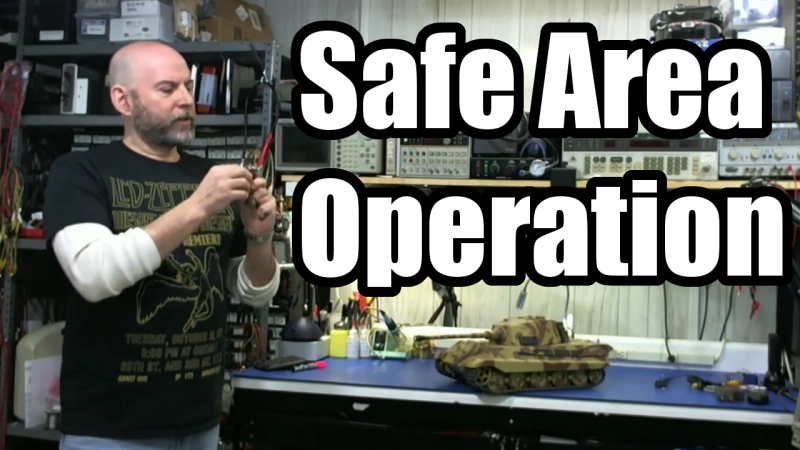We’re back and this time talking about Safe Operating Area also called Safe Area Operation (SAO) which is short for the combination of things that can conspire to ruin your design. We also talk about helicopters.
Why take all of this time to discuss SAO you might ask, and what is that business about helicopters? Depending on the design there may be quite a bit of tedious math involved and sometimes there is just no avoiding it. Alternatively if you can get a feel for when math is and is not critical (based on design choices), it should be easier to get your next project up and running while still obeying the rules of the road.

Components, especially those that generate heat like the Power MOSFET shown above, come with a fairly well-defined set of operational specifications. Those specs make up the SAO; they’re the circumstances under which you can ensure consistent operation while maintaining the reliability of the part . So while there is a time for detail there is also the conceptual phase where one might hold up ideas to the problem and check the fit while using some placeholder type values.
So unbeknownst to the gentle viewers at home, we have a plan; No we are not interested in world domination, we tried that with the Z80 and failed. What we ARE interested in is helping up and coming designers, including even a few of us burnt-out types, to get an intuitive feel for different ways to solve some common problems.

An example design where SAO may be involved could have several facets: Should we use switched instead of linear operation? Do we need to be careful picking the right part or will any one of several works? Will it get hot?
If you don’t know what we’re talking about, the video at the top includes an excellent example at about 3:40 when the rheostat for a decades-old motorized tank is shown. The crude motor controller was in the wrong position for too long creating so much heat that it melted a hole in the plastic case. While this is a simple example we can view it as an example of trading off resistance, current and voltage while hopefully keeping it cool.

This brings us back full circle; why involve the venerable helicopter and is that just a cheap stunt to try to get interest? The answer is yes, it’s a stunt — but helicopters do have an SAO, or Deadman’s Curve, that is graphed between height and forward velocity. The Deadman’s Curve simply means that there is a huge area where the craft can operate properly without worrying about the math, and then there is an area where it’s all about the math.

Still with us after the tanks and helicopters? Great, time for the actual math. At the 5:30 mark you’ll get the meat and potatoes of how to read and understand an SAO graph like the one seen to the right.
We can also trade off time for heat and short pulses can consequently handle higher current as shown by the dashed lines. This can be useful in other devices such as LED’s where the human eye registers the peak output during the short pulses and yet, thanks to a phenomenon known as persistence of vision, doesn’t record the fact that the LED spends a portion of time turned off and cooling.
Near the end of the video we discuss why the “ON resistance” — often shown as RDS(on) — of a MOSFET has a huge effect on power dissipation for that part. This is due to the fact that with a restive load the power dissipation goes up with the square of the current times the resistance of the load (P = I2R). A very small change in the on resistance will have a very large effect on the power dissipation. For an understanding of the creation and effects of temperature check the last Hackaday Video regarding heat.
At the end of the day all of this means that if you are on the wrong side of the SAO equation your design can get overheated or otherwise stressed and suffer from a variety of issues that should be avoided. SAO isn’t used to prove something is impossible, more often it is one of the tools for finding out what is possible and what the trade-offs are. Sometimes the answer is the designer needs to start over or look for other approaches to a problem if the SAO determines that “you can’t get there from here”, or in the words of the WOPR “The only winning move is not to play”. Often this means go switched or go home. The good news is that there are some real kick-ass switching outputs available these days.
















Haven’t watched the video, all I know is I want that model (presumably R/C) of that E-75
Tiger II “King Tiger” :)
Huh. I have literally never heard it said “SAO”, always “SOA”. Is it a regional thing?
If google or wiki haven’t heard of “SAO”, chances are that it is not used as an alternative for SOA.
This type of stuff *should* be picked up by a competent editor/tech writer.
Heh, knowing Bill this is just the way it used to be done before the age of Google. I’m still always tickled when he refers to Datasheets as Databooks. :-)
Keep up the good work Bill, don’t know about everyone else but this stuff is all new to me.
Sorry it’s easy to disregard criticism and the critic, when the critic doesn’t indicate they understand how weak evidence based on a web search can be. I didn’t take Bill’s Statement to say that SAO is synonymous with SOA. I took it as heads up if we are searching for such data an different nomenclature my be used.
Sheet I figured I’d make that mistake despite how careful I tried not to.
Google search isn’t a weak source as you implied. It does have access to a lot of technical books that are digitized and other technical and part vendor web site reference. The fact is that the term is not near the top of the search list means that there is a high chance that it is some *non-professional* terms that someone made up and very rarely used else where.
The way the OP is written seems to mislead everyone else that it is a proper way of saying the same thing. I wasn’t the first person to point out that it is not a proper term. The burden is on the staff/contractor that wrote the OP to show that the “SAO” to show that it is a proper term. As such Bill admit he started using that term 35 years ago on his own.
>We’re back and this time talking about Safe Operating Area also called Safe Area Operation (SAO)
Which actually have said:
>We’re back and this time talking about Safe Operating Area also called *by Bill* Safe Area Operation (SAO)
Watch the video or RTFDS… Hmmm? Not to be an ass, but seriously, this stuff is all right there if you would bother to read. This reminds me of the relationship techs have to engineers – Its always funny to me – Engineers always get their asses handed to them when it comes to the pratical, real world common sense type of gotchas and techs always get spanked by not bothering to do the math.
I’m diggin the hell out of these videos, Bill! Don’t change a thing
Definitely not that C=offee mug!
Yes I referred to it as more verb-like -“safe area operation” starting over 35 years ago and long before Google. If referring to noun-ish I call it “safe operating area”. Either way the point was not only how to do the math, but when to do the math and to explain a little about switching vs linear.
Model is a King Tiger that I bought in Tokyo in ’85. It looks a lot like the E-75 in World of Tanks. ;)
And yes Ben:, databook. >:) I have 600 of them and will have to feature them some time as some are even hardback. To make a datasheet you had to stand at the photocopier mashing the book flat or hope that the local rep had one in his trunk with the golf clubs.
Next episode we are going to play with some FPGA type stuff and get away from all of this math stuff now that I have the various pieces playing nice together.
It’s irresponsible to use made-up terms while trying to educate people. They won’t be able to communicate effectively with properly-educated people.
It’s like how scientology and mormonism make up subtly different meanings for normal words, so their members have a hard time leaving for the normal world.
No doubt that SAO in the electronics context might be good to know in the future, the trick is going to be remering this video and who put it on the web. More videos like these please